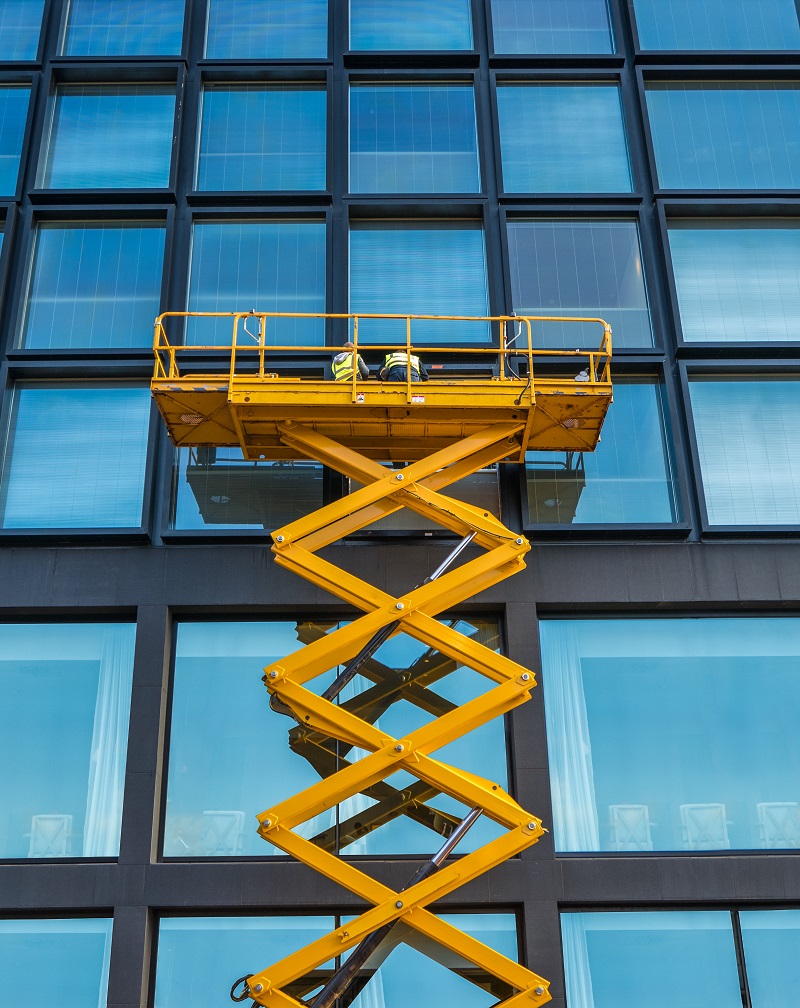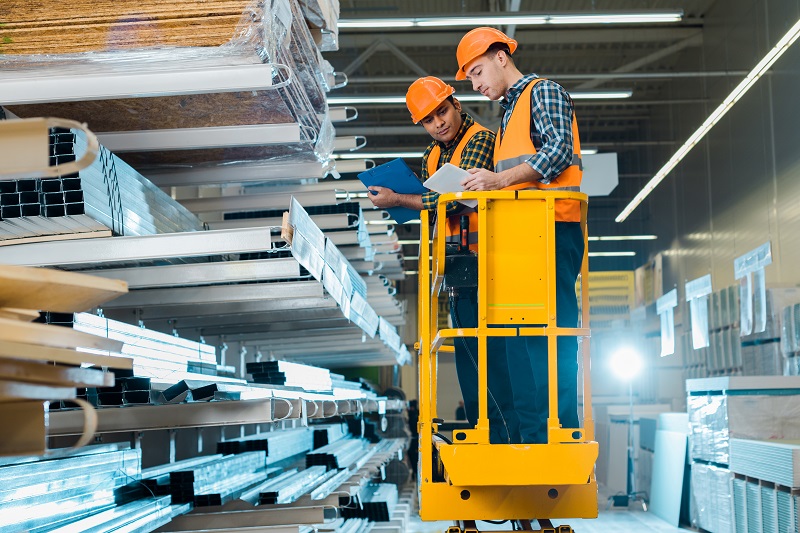When it comes to OSHA compliance, the more dangerous a piece of equipment is to use, the more rules and regulations are attached to it. A substantial one to note are OSHA scissor lift requirements.
With more rules and regulations, it becomes more difficult to be 100% compliant without overlooking a few things.
But, even the smallest negligences can result in big fines and penalties, not to mention the safety consequences of injury or death.
To get you started on the right track, we’ve compiled this brief guide of the essentials you need to know about OSHA MEWP and scissor lift safety requirements.
What Does Scissor Lift Training Entail?
Scissor lifts (also classified as MEWPs [Mobile Elevating Work Platforms]) can be dangerous, so. only properly trained workers should be permitted to use and operate them.
Scissor lift training includes:
- evaluating stability and positioning before use;
- ensuring equipment is functioning and being properly maintained before use and reporting any equipment defects;
- learning the manufacturer’s instructions for use, including vertically and while in transit;
- weight limits on the scissor lift and how to handle materials on it;
- identifying other potential hazards, like contact with electrical wires;
- knowing which personal protective equipment (PPE) is necessary when; and
- implementing safe work practices.

What Are the Essentials for Scissor Lift Safety?
Focusing on the following three factors are a great foundation for scissor lift safety:
- Stabilization
- Positioning
- Fall protection
Stabilization of Scissor Lifts
To stop the scissor lift from tipping over or collapsing, ensuring scissor lift stabilization is essential.
- Don’t move the scissor lift if it’s in an elevated position, as this can cause swaying.
- Ensure that the scissor lift is in an isolated area without the possibility of something (like other equipment) bumping into it.
- Situate the scissor lift on firm, level surfaces free from holes, slopes, bumps, debris or obstruction.
- Only use the scissor lift outside if the wind speeds are less than 28 miles per hour.
Scissor Lift Operators Positioning Scissor Lifts
OSHA standards require scissor lift operators to take extra caution when positioning scissor lifts.
The two major scissor lift hazards regarding positioning are:
- Contact with overhead power lines
- Trapping between equipment
To avoid accidents, scissor lift operators should be aware of:
- fixed objects near the scissor lift and in its path;
- moving vehicles near the scissor lift and in its path; and
- overhead objects such as a door frame or support beam.
Take note that it’s not solely the responsibility of the workers operating scissor lifts to ensure safe positioning. Traffic control measures should be implemented around the scissor lifts, as well as ground guides.
If an electrical source is unavoidable, scissor lift operators should be properly qualified to manage this and have received the required electrical training.
Electricity is capable of arcing or jumping from a power line to a scissor lift or worker even if they aren’t touching. Scissor lift safety, therefore, includes positioning the scissor lift correctly when near energized power lines to avoid electrocution, arc flashes, and thermal burns.
Fall Protection Such as Scissor Lift Harnesses
Fall protection devices can be divided into two parts:
- guardrail systems, and
- safety harnesses.
The guardrail system installed should be inspected and confirmed fit for use before operating the scissor lift to ensure the safety of workers by increasing fall protection.
The scissor lift should be positioned in such a way that workers can prevent accidents and avoid leaning over the guardrail system or having to stand on the guardrails.
A scissor lift harness isn’t part of the OSHA scissor lift requirements for fall protection to improve worker safety, and can be considered as an additional fall protection device.
You as an employer may choose to implement safety harnesses as a part of your workers’ PPE, and OSHA regulations emphasize that workers receive proper training on how to use them.
The best practice is to wear a harness during scissor lift usage if there is a secure tie-off point included.
Although according to OSHA standards, a functioning guardrail system is adequate fall protection, if you implement scissor lift harnesses as part of the company’s safety policy, your workers will be required to wear them.
Some workers might opt for a safety harness when working on a scissor lift for their peace of mind. You then need to have them available, as well as provide the necessary training.
You will still be OSHA compliant without safety harnesses if the guardrail is adequate, but we recommend using them when:
- The scissor lift work platform is higher than six feet;
- wearing a harness is part of the scissor lift manufacturer’s instructions; and
- a worker leaves the elevated aerial lift work platform.
Keep in mind that OSHA requirements don’t include safety harnesses simply because guardrails can and should provide adequate fall protection on their own. If you ensure that the scissor lift guardrails are up to scratch, you often don’t have to worry about harnesses at all.

Do You Know Where the Safety Gaps Are in Your Company?
At Insure Compliance, we have formulated a unique Safety Gap Model using our years of onsite experience and observation.
By reviewing a safety program holistically, we can better identify where gaps exist. We then work with you to help you solve them and become fully OSHA compliant, as well as reduce possible hazards and reduce injuries.
You can start by taking our short online safety audit, and one of our representatives will give you a follow-up call or email to discuss the way forward.
We offer extensive scissor lift policy safety training and aerial lift training for both management and workers, including general training and compliance training. This can be supplemented with our preliminary job site hazard analysis and inspections to ensure employee behavior is following the training.
In addition, most employers find our Injury and Illness Protection Program (IIPP) Training to be particularly fruitful thanks to the benefits it reaps across various tiers:
- it teaches workers the basic workplace safety and health guidelines;
- it minimizes risk in the workplace;
- it will increase the insurance requirements being met; and
- it prepares management to better help with the company safety program.
Key Takeaways
The two most important things to note when it comes to OSHA scissor lift requirements are that your staff need adequate and specialized training. The equipment needs to be evaluated as safe and fully functioning before every single use.
Guardrails are considered OSHA compliant safety systems if they are up to standard, and safety harnesses may be implemented at the employer or employee’s discretion so long as there is the correct training.
By implementing meaningful rules and practices around scissor lift safety, you can put your own and your workers’ minds at ease.
We can help you every step of the way, from addressing your safety gaps to staff training, to helping you prepare for when an OSHA inspector arrives one day and what to expect, to a mock OSHA audit.
We can help you increase your scissor lift safety and everything in between. Contact us to get started today.
Disclaimer:
Please note that every effort has been made to ensure that the information provided in this guide is accurate. You should note, however, that the information is intended as a guide only, providing an overview of general information available to businesses. This guide is not intended to be an exhaustive source of information and should not be seen to constitute legal, safety or business advice. You should, where necessary, seek your own advice for any issues raised in your affairs.







One Response